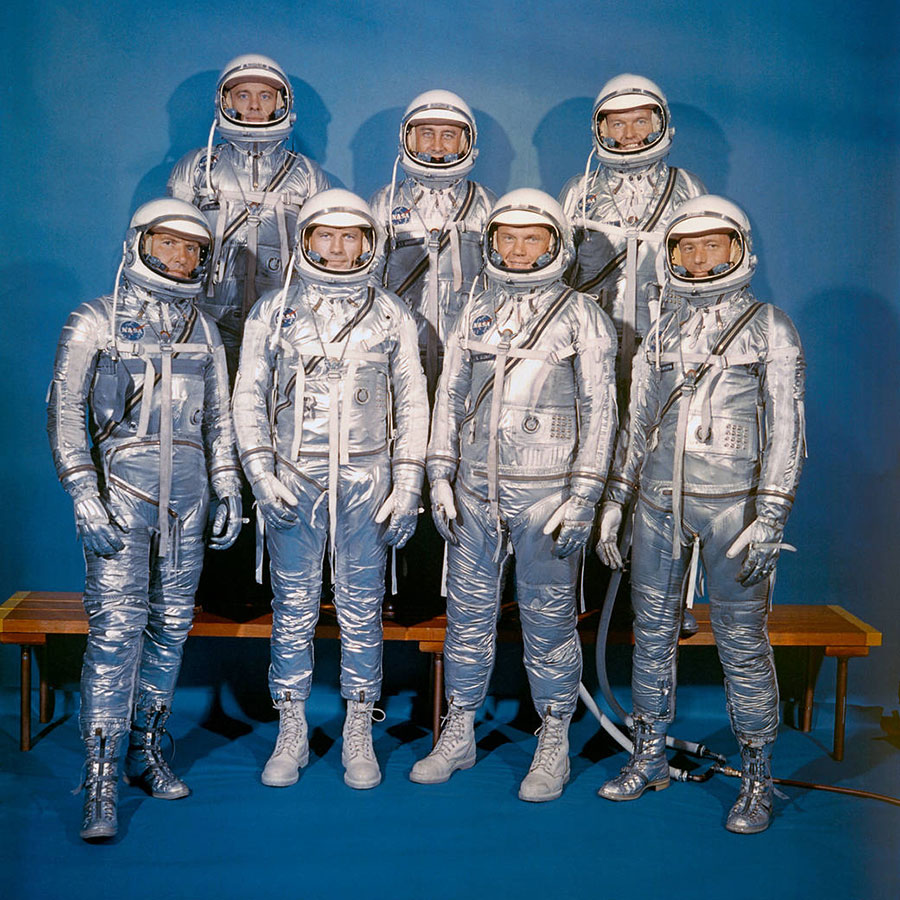On October 1, 1958, the National Aeronautics and Space Administration, or NASA, officially opened for business. Just a few months prior on July 29, President Dwight Eisenhower signed the act that approved NASA to conduct research and testing for space sciences. It was in response to the Soviet Union’s space achievements and sparked what has now spanned 60 years and is still ongoing.
The next year, on April 9, 1959, NASA announced the Mercury 7 astronauts who would pioneer into the unknown and test whether or not humans could survive in space.

Following the Mercury 7, Project Gemini pushed the boundaries and perfected a spacecraft that could carry two astronauts on the next phase to reach the Moon.
All of this led to the famous Apollo Program where humans walked on and explored the Moon. There were many cultural impacts from this program and the “Space Race.” A significant one was a new perspective of Earth after the Apollo 8 astronauts shared the Earthrise photograph. Seeing how fragile Earth was sparked a movement to protect the planet we call home.
Even when the Apollo Program ended, NASA continued on with new, innovative ideas. In 1981, the Space Shuttle Program launched on its first orbital mission. For the first time, NASA had a fleet of five reusable spacecraft: Atlantis, Columbia, Challenger, Endeavour and Discover. The space shuttles could carry up to seven astronauts at a time, launching like a rocket and landing like an airplane. They also played a huge role in building the International Space Station. Space Shuttle Atlantis is now displayed here at Kennedy Space Center Visitor Complex!
To celebrate NASA’s 60th Anniversary, we’ve compiled key milestones below.
- January 31, 1958: Explorer 1 satellite launched from Cape Canaveral. It’s credited with discovering belts of charged particles in Earth’s magnetic field, now known as the Van Allen Belts.
- July 29, 1958: The National Aeronautics and Space Act was signed by President Dwight Eisenhower.
- October 1, 1958: NASA opened for business.
- April 9, 1959: The first astronauts were announced by NASA, nicknamed the Mercury 7.
- May 5, 1961: Astronaut Alan Shepard became the first American in space during a 15-minute suborbital flight in his Freedom 7 Mercury capsule. He famously said, “Fix your little problem and light this candle,” after waiting on the launch pad for more than four hours.
- May 25, 1961:Shortly after Alan Shepard’s historic flight, President John F. Kennedy announced America’s goal to land humans on the Moon before the end of the decade.
- February 20, 1962: John Glenn became the first American to orbit Earth three times in under five hours.
- June 3, 1965: First American spacewalk by Ed White, testing out spacesuit technology. Today, spacewalks happen often and can last anywhere between 5-8 hours on the International Space Station (ISS).
- January 27, 1967: Apollo 1 crew, Gus Grissom, Ed White and Roger Chaffee, passed away in a capsule fire. Their sacrifice led to safer processes and procedures for future Apollo missions.
- December 24, 1968: Apollo 8 crew saw the Earth while orbiting the Moon for the first time. They took the famous Earthrise photograph and spent Christmas in space.
- July 20, 1969: Apollo 11, Neil Armstrong and Buzz Aldrin, became the first men to walk on the Moon.
- May 14, 1973: The first U.S. space station, Skylab, launched.
- August 20 & September 9, 1975: NASA launched the first spacecraft to Mars: Viking 1 and 2. They became the first U.S. mission to land safely on Mars and return images of its surface. As our knowledge of the planet increases, so does the opportunity to send humans to explore Mars.
- April 12, 1981: The first orbital flight of NASA’s space shuttle. The space shuttle was the first reusable spacecraft and all five orbiters flew a cumulative of 135 missions until the program was retired in 2011.
- January 28, 1986: Space Shuttle Challenger crew passed away in a tragic accident after launch.
- April 25, 1990: Hubble Space Telescope deployed. This spacecraft has travelled more than 4 billion miles in a low Earth orbit since its launch and made more than 1.3 million observations of our universe.
- November 17, 1993: The United States, Russia, Japan and the European Space Agency announced they would work together to build the International Space Station (ISS). A total of 15 countries participated in building the ISS, which took 13 years to complete.
- February 1, 2003: Space Shuttle Columbia was lost in an accident after re-entry.
- October 7, 2012: The first commercial resupply mission launched atop a SpaceX Falcon 9 rocket with the Dragon spacecraft. See the Dragon capsule in our NASA Now exhibit during your next visit!
- December 5, 2014: NASA’s Orion capsule completed its first spaceflight test, EFT-1, after launching on a Delta IV Heavy rocket. This is also on display in NASA Now. Come see it up close!
These are just a few of the great things NASA has accomplished in the last 60 years. The Space Shuttle Program ended in 2011, but the spirit of exploration lives on as NASA focuses on returning to the Moon, and exploring Mars. We have entered into a new age of space with NASA’s partnership with commercial companies, and the Commercial Crew Program that will launch Americans from Florida’s Space Coast as early as 2019, making Kennedy Space Center a multi-user spaceport!
The accomplishments NASA has made over the past 60 years are all stepping stones to greater and exciting things. They will work to increase an understanding of Earth, and strive to answer the question, “Are we alone?” You can learn more about what’s happening now and NASA’s plans for the future at our NASA Now and Journey to Mars: Explorers Wanted exhibits.




